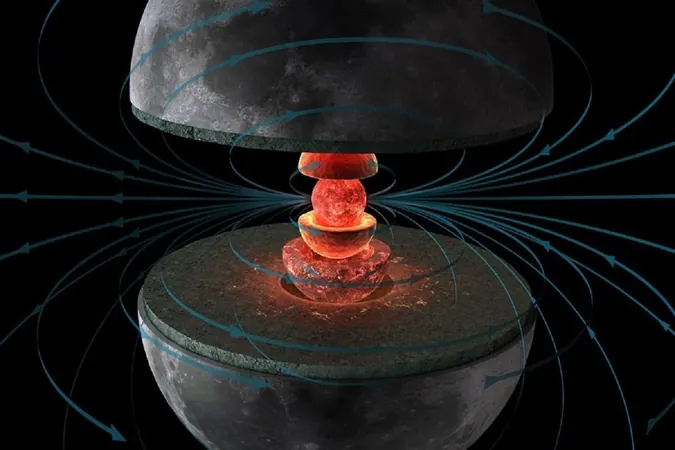
Groundbreaking Discovery: Moon's Lava Stayed Hot for Eons Longer Than We Thought!
2025-07-29
Author: Noah
Unveiling the Moon's Fiery Past
In a stunning revelation poised to reshape our understanding of the Moon's history, recent studies suggest that lava exists in the Moon's subsurface far longer than anyone previously imagined. This extraordinary finding stems from the latest data gathered by China's Chang'e-5 probe, which challenges the long-held theories about the Moon’s thermal evolution.
The Giant Impact Hypothesis: A Fiery Origin
According to the prevailing Giant Impact Hypothesis, the Moon was born about 4.5 billion years ago when a Mars-sized body named Theia collided with a molten Earth. This cosmic collision crafted the Earth-Moon system, leading scientists to believe that the Moon cooled from the outside in, causing its crust to solidify and halting lava flows early on.
Chang'e-5 Samples Rewrite History
However, the Chang'e-5 mission unearthed intriguing samples from the mare basalt unit in Oceanus Procellarum—the Moon's vast basalt plains. Weighing in at 1.7 kilograms (3.7 pounds), these specimens date back approximately 2 billion years, marking them as the youngest lunar samples ever collected. These findings directly contradict former theories that claimed the Moon's upper layers were simply too cool for melting.
An International Team Leads the Charge
The groundbreaking research was orchestrated by Stephen M. Elardo, an Assistant Professor at the Florida Planets Lab, alongside a formidable team of experts from esteemed institutions including the Colorado School of Mines, University of Rochester, and the University of Oxford. Their findings were published in the prestigious journal *Science Advances* on July 18.
The Secrets of Shallow Magma Revealed
The Chang'e-5 samples reveal lava formed from rapid cooling, characteristic of the mare regions. To understand the depth from which this lava originated, researchers conducted high-pressure, high-temperature experiments mimicking the moon's conditions. Past studies had hinted at the presence of radioactive elements like potassium, thorium, and uranium in the eruption sites, suggesting they might have generated enough heat to keep the Moon's crust warm and responsive for millions of years.
A New Model for Lunar Cooling
Previously, it was believed that the Moon's upper mantle cooled first, with any hot lava coming from its deep mantle. But new findings indicate that there were hot pockets within the shallow mantle that melted rock up to 2 billion years ago. Elardo remarked, 'We demonstrated that an abundance of radioactive elements would have kept the upper mantle hundreds of degrees hotter than previously assumed, even back then.'
Unlocking the Moon's Chemical Secrets
The study of lunar magmatism provides invaluable insights into the composition of the Moon's mantle—an elusive treasure trove of knowledge since no direct samples have been collected. This knowledge is vital to piecing together the Moon's evolutionary timeline, crucial for understanding planetary formation.
The Road Ahead for Lunar Exploration
Elardo envisions this study sparking a surge in lunar geodynamics research, a complex field that models the movement and cooling of planetary interiors. With more data points at researchers' disposal, this could refine our understanding of not just the Moon, but also the formation and evolution of planetary bodies throughout the universe.
Conclusion: A New Era for Lunar Studies
These revelations from the Chang'e-5 mission mark a monumental step in lunar research. As we uncover more about our celestial neighbor, we draw closer to deciphering the intricate processes that govern the universe's many worlds.









 Brasil (PT)
Brasil (PT)
 Canada (EN)
Canada (EN)
 Chile (ES)
Chile (ES)
 Česko (CS)
Česko (CS)
 대한민국 (KO)
대한민국 (KO)
 España (ES)
España (ES)
 France (FR)
France (FR)
 Hong Kong (EN)
Hong Kong (EN)
 Italia (IT)
Italia (IT)
 日本 (JA)
日本 (JA)
 Magyarország (HU)
Magyarország (HU)
 Norge (NO)
Norge (NO)
 Polska (PL)
Polska (PL)
 Schweiz (DE)
Schweiz (DE)
 Singapore (EN)
Singapore (EN)
 Sverige (SV)
Sverige (SV)
 Suomi (FI)
Suomi (FI)
 Türkiye (TR)
Türkiye (TR)
 الإمارات العربية المتحدة (AR)
الإمارات العربية المتحدة (AR)